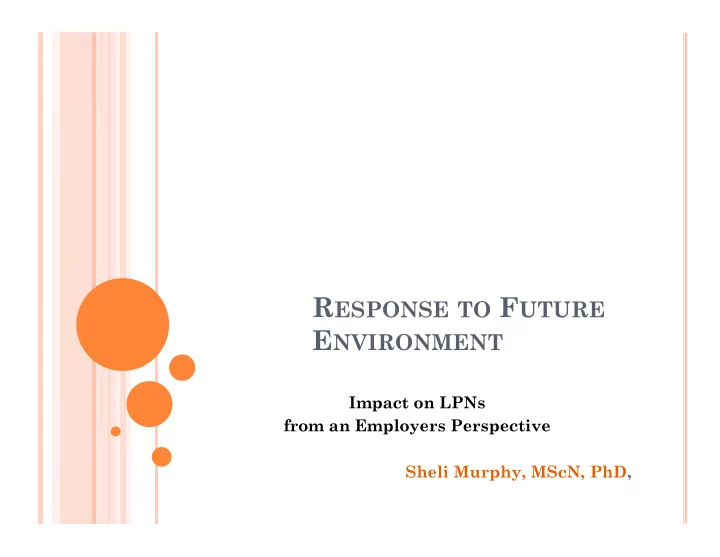

R ESPONSE TO F UTURE E NVIRONMENT Impact on LPNs from an Employers Perspective Sheli Murphy, MScN, PhD,
P LANNING FOR THE RIGHT FUTURE The future is here – we have yet to grasp it and make the necessary changes to realize the benefits already available.
D ESIGNING A F UTURE OF C OLLABORATIVE C ARE “ Interdisciplinary collaboration refers to the positive interaction of two or more health professionals, who bring their unique skills and knowledge, to assist patients/clients and families with their health decisions (CMA, 2007).”
C OLLABORATIVE P RACTICE G OALS Optimizing Canadians' access to the skills and competencies of a wide range of health professionals. Improving primary and even specialty health care by further encouraging and facilitating health promotion and the prevention of illness. Collaborative care is promoted as a solution to health human resource shortages, and as a way of increasing access to and improving the quality of care. Leads to the best use of the health human resources available.(CMPA, n.d.) Considers professionals working to their optimal practice in given environments.
T HREE P ROFESSIONAL N URSING G ROUPS LPN S , RN S RPN S All professional nursing regulatory bodies are accountable to the public for the provision of safe, ethical, competent nursing care through authority granted in provincial legislation. Each regulatory body is responsible for the development of codes of ethics, standards of practice, and the approval of nursing education programs. Each regulatory body has the authority to define the scope of practice of their respective members (Uof A, n.d.)
CLPNA LPNs have a broad scope of practice, guided by a comprehensive framework that includes legislation, regulation, standards, education, competencies, continuing competence, and employer policy. The LPN profession provides a vital role in health service delivery. LPNs provide quality care to Albertans within a system experiencing an aging population, increasing complexity of care, and continuing demands for adequate resource utilization. (CLPNA,, 2013)
N EAR F UTURE FOR ALL N URSING G ROUPS LPNs working to full scope of practice RNs/RPNs moving to full scope of practice NPs advancing their scope of practice
N EAR F UTURE FOR THE T EAM Patient/Resident/Client Centered Care Enhanced through partnering with them. Collaborative practice in settings where there are multiple providers. Ensuring all providers are afforded opportunities to practice their full scope appropriate for the environment
H EALTH C ARE P ROVIDER S HORTAGE PROJECTED ? Year 7 Year 14 Year 21 Year 28 MD 1 2 3 4 NP 1.4 2.8 4.2 5.6 RN 1.75 3.5 5.25 7 LPN 3.5 7 10.5 14 HCA 22.75 45.5 68.25 91
C RYSTAL B ALL
S O W HAT C OULD T HE F UTURE B RING Scenario for Consideration Continuing care as just that ….. ‘a continuum of care outside of Acute care’….. LPNs taken a leadership role; RNs/RPNs taking a health coach role (primary care and wellness interface) working with families and other ‘personal community ‘ supports; NPs (and team), at the request of the RN responding to situations that may require transfer of individuals to ED or Acute Care.
L ONGER T ERM Dependent upon factors Economy User demand – who makes decisions Public desire to stay well Need for all interventions available at all stages of life Supply of providers Technology development Public determination for tax dollar distribution for education of providers for building repair, restoration, redevelopment for providing core business versus high level interventions urbanization versus close to home of care provision
E VEN L ONGER T ERM Technology will trump people… Robots doing visits – creating linkages to the right expert. Imbedded computer chips in routinely used equipment. Hand held scanning devices. Individuals making their own health decisions and health plans. Access to ‘experts’ on line and to whom they want to get the advice from. …what will the collaborative team look like then?
CLPNA (2013), http://www.clpna.com/wp- content/uploads/2013/02/doc_FACT_SHEET_Sco pe_of_Practice_for_LPNs_in_Alberta_2013.pdf CMA (2007), http://www.fhs.mcmaster.ca/surgery/documents/C ollaborativeCareBackgrounderRevised.pdf CMPA (n.d.) http://www.cmpa- acpm.ca/cmpapd04/docs/submissions_papers/com _collaborative_care-e.cfm
U of A , Faculty of Nursing (n.d.) http://www.nursing.ualberta.ca/en/Undergraduate/ FAQ/AsktheStudentRecruiter/NursingDesignatio ns.aspx WorldHealth Net, (2012). https://www.worldhealth.net/news/star-trek-3d- handheld-medical-scanner-debuts/
Recommend
More recommend